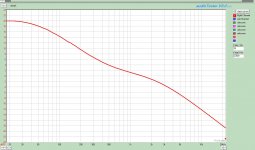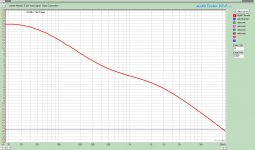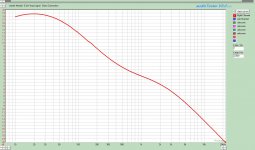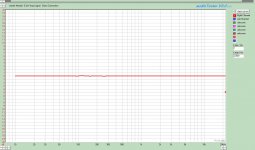Mix those in first stages in 4 doublets. 8.39+8.33 x2 8.38+8.34 x2
8.33 x 2 pcs
8.34 x 4 pcs
8.38 x 2 pcs
8.39 x 2 pcs
Use those by one for each second stage
8.51
8.52
8.53
8.54
Use trimmers instead of Rs second stage so to bring each channel same Vo RMS
From the left overs use 4 closer ones for buffers.
8.33 x 2 pcs
8.34 x 4 pcs
8.38 x 2 pcs
8.39 x 2 pcs
Use those by one for each second stage
8.51
8.52
8.53
8.54
Use trimmers instead of Rs second stage so to bring each channel same Vo RMS
From the left overs use 4 closer ones for buffers.
Textbook is 19.27dB at 20Hz and -19.62dB at 20kHz when 1kHz = 0dB. Make a 0dB 1kHz crossing by adding what is needed for level in the memory bank and confine in 40dB range so to see it in context. No don't change the load, it will swing. Add to the C3 value step by step.
Represented that way it looks close to text book. Found a neat little checkbox that does the 0dB at 1kHz automatically. Nice
Added an expanded plot showing more of the LF response. THE LF roll off helps it stay short of target.
Added an expanded plot showing more of the LF response. THE LF roll off helps it stay short of target.
Attachments
Last edited:
Its very good. Is there in any way any flattening file that can be just a wee bit off? If not, we are in experimental error territory of the LCR bridge, measurement set up etc. Add 270pF silver mica to your HF Riaa cap. Measure, but where we are now, mainly listen in the context of your speakers and room. If it will go bland, check out 150pF.
The LF will roll off a bit at the low sonic edge because it has to make a high pass for rumble too. Also we don't know how the high source series Z of the divider that feeds current to the shunt 15R copes in combination with the card. Down there its your speaker & room interface that reigns. Modal region. See to bring it mainly subjectively where you like to the right of 1kHz. Left hand has the proper shape. 20Hz will not do something real.
The LF will roll off a bit at the low sonic edge because it has to make a high pass for rumble too. Also we don't know how the high source series Z of the divider that feeds current to the shunt 15R copes in combination with the card. Down there its your speaker & room interface that reigns. Modal region. See to bring it mainly subjectively where you like to the right of 1kHz. Left hand has the proper shape. 20Hz will not do something real.
I think that I will leave it as is. I agee it is within error of measurement. The flattening file was flat.
The issue I am having, and have had even before v1.2 was that the bass is not a strong as I would like. Given response of riaa I will look towards TT as culprit. I even pulle he TT stand out and away from speaker thinking it was being effected but no diff.
What I don't want to mess with is the musicality, detail and soundstage. This thing is crazy good in those departments. I now suspect it is equally good in bass but have to get it the proper signal.
The other thing may be that I have not heard real good HF in nearly 20yrs due to the digital revolution and kids. CD's served their purpose for that period.
The issue I am having, and have had even before v1.2 was that the bass is not a strong as I would like. Given response of riaa I will look towards TT as culprit. I even pulle he TT stand out and away from speaker thinking it was being effected but no diff.
What I don't want to mess with is the musicality, detail and soundstage. This thing is crazy good in those departments. I now suspect it is equally good in bass but have to get it the proper signal.
The other thing may be that I have not heard real good HF in nearly 20yrs due to the digital revolution and kids. CD's served their purpose for that period.
Yep. Add 270pF, measure and listen, and let us know. Just use Mica. Mine hits the 19.27 at 20Hz. But it may be the capacitor tolerances and our LCR. It will have bass if it does not have a bit more presence than absolutely correct in the mid highs. Its a psychoacoustic scales. You probably need to save off a wee bit towards last octave. Tune it out without changing the main caps. Also you use styroflex, some find it a bit glassy beyond very clear.
I assume you mean add 270pF to C3. How about 250pF as that is what I have.;-) WIll have to do that tomorrow. Getting late, and I have to pull the boards to change them. I did put a spot in for it so it will be an easy mod.
Right now it is playing music very well. King Crimson Islands.
P.S. attached is a direct feed through with load of divider
Right now it is playing music very well. King Crimson Islands.
P.S. attached is a direct feed through with load of divider
Attachments
Last edited:
250pf very good. Just see it is a near matching pair as a whole with C3s. If you decide its too saved off try 150pF, if still a bit happy in HF try 330pF. The goal is to be subjectively correct with your amps, speakers, room, cart. Its in the ballpark anyway, you can't throw it out of balance hard with such small additions. When you will find your sweet spot take a measurement to see what the FFT catches and how big was the deal. It will be interesting.
The load of divider on card's input? If yes, its high Z easy. The phono is 150R.
The load of divider on card's input? If yes, its high Z easy. The phono is 150R.
- Home
- Source & Line
- Analogue Source
- Simplistic NJFET RIAA



